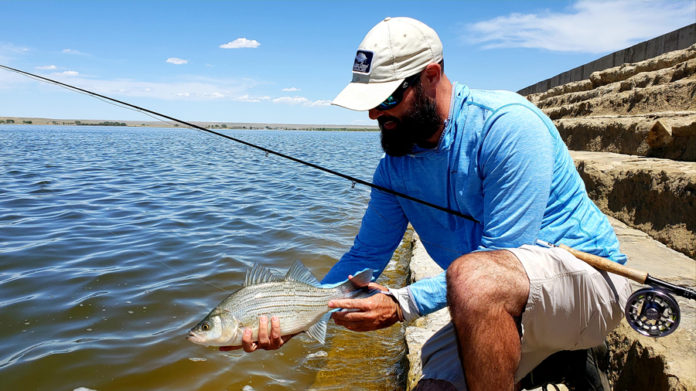Written by: Evan Jones
Photos courtesy Evan Jones
Fishing options can feel a bit limited during late spring: runoff is usually in full force, steelhead are mostly done for the season, and high-latitude or high-alpine areas aren’t yet accessible. For anglers living near the shaded regions in the map below, however, late spring is the perfect time to visit your local reservoir to fish for hybrid striped/white bass, also known as “wipers.” These notoriously hard-fighting fish are often found roaming the shoreline in schools when the water reaches 55 degrees, staying near the shallows until the heat of summer drives them back into deeper water, making them easy to target during this time even without a boat. While catching wipers is a lot of fun, fishing for them can be very hit-or-miss, so here are three tips to help you maximize your time on the water this season:

1. Persistence Pays
Finding wipers is arguably the hardest part of catching one. Their tendency to school up and move around frequently lends credence to the old adage that 90% of the water is vacant 90% of the time. Your goal is to cover enough water that you eventually end up at the right place at the right time, which might require multiple trips over several days. Once you find the wipers, however, action is usually intense and well worth the time invested.

Inlets and outlets are good places to prospect, and so are shallow shelves with deeper water nearby. Look for diving birds or schools of bait, and keep an eye out for cruising wipers, especially along the windward side of the lake where the waves are highest and the food is more densely concentrated.
2. Get Down to the Fish

While it’s not impossible to catch wiper on surface flies, the vast majority of these fish feed in the lower half of the water column. This is particularly true of the larger fish, which tend to hang out below the schoolies and feast on injured bait raining down from the frenzy above. A 200-300 grain full-sinking line is ideal, since it not only keeps your fly near the bottom, but also allows you to throw less heavily-weighted flies, which are easier to cast and less likely to snag. If you don’t have a full-sinking line, or don’t enjoy casting them, a sinking-tip line will also work. You can use a floating line with a long fluorocarbon leader and a heavier fly, although it’s harder to cast and requires you to wait for the fly to sink, limiting your fishing time.
3. Use Flies with Less Flash

If the area you’re fishing is also under heavy angling pressure from spin casters, the wipers have already seen plenty of flashy lures, and will often begin to associate excessive flash with danger. This wariness can potentially give fly anglers an advantage, since very few lures lack flash, but it’s easy to tie a fly without any, or to simply remove the flash from an existing fly. My favorite option is a classic white-and-chartreuse Clouser Minnow, but any baitfish pattern in any color combination works, so long as it’s tied with natural materials that aren’t too shiny.

Credit: Source link































